In this guide:
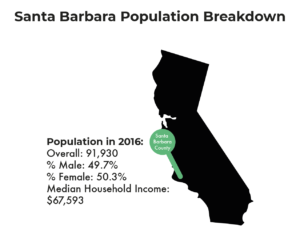 Santa Barbara is a thriving medium-sized city. Located on the west coast of California, by 2016, the population was at 91, 930 with a split between 49.7% males and 50.3% female. Taking in the surrounding communities, including Carpinteria, Summerland, Montecito, and Goleta pushes that number closer to 400,000. The estimated median household income in 2016 was $67,593 compared to the median household income for California as a whole which was $67,739.
Santa Barbara is a thriving medium-sized city. Located on the west coast of California, by 2016, the population was at 91, 930 with a split between 49.7% males and 50.3% female. Taking in the surrounding communities, including Carpinteria, Summerland, Montecito, and Goleta pushes that number closer to 400,000. The estimated median household income in 2016 was $67,593 compared to the median household income for California as a whole which was $67,739.
Situated 90 miles north of Los Angeles and 350 miles south of San Francisco, Santa Barbara is located between the Santa Ynez mountains and the Santa Barbara Channel. Its city limits are contained with 18 square miles which extends to 43.1 square miles if you add the water. The coastline is placed in such a way that it faces south.
Depression is something that affects many people in the community. It has been measured in Santa Barbara County in 2016 with the question: “Has a doctor ever told you that you have a depressive disorder (including depression, major depression, dysthymia, or minor depression)?”
Overall: 18.3
Male 14.6
Female 22.0
Hispanic 13.2
Non-Hispanic White 23.0
Other 11.6
This compares to California’s numbers:
Overall: 13.3
Male 10.1
Female 16.4
Hispanic 11.2
Non-Hispanic White 17.3
Other N/A
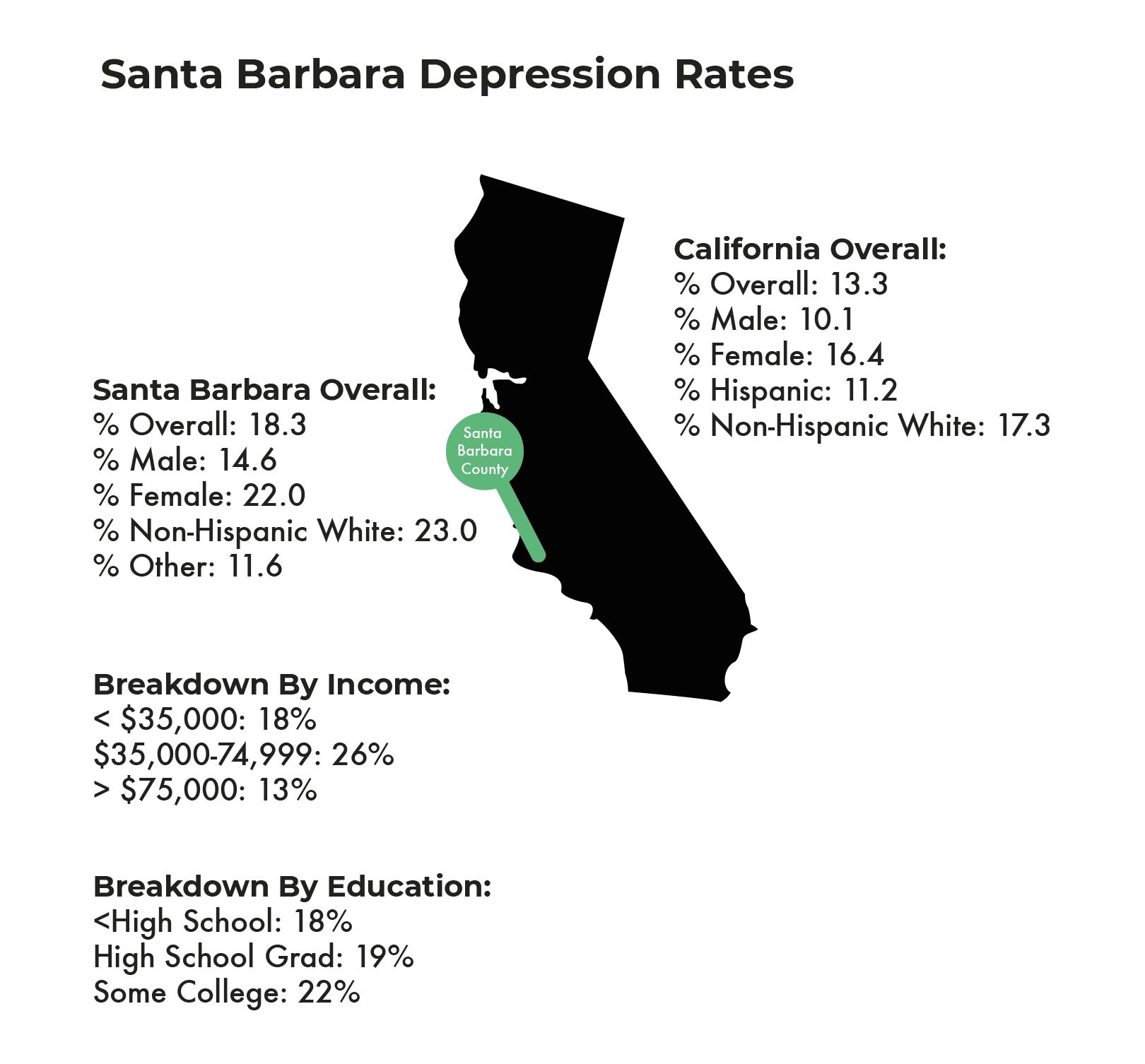
The percentage of adults reporting depression by educational attainment and income breaks down thusly:
Less Than High School 18%
High School Grad 19%
Some College 22%
College Grad 14%
Income Less Than $35,000 18%
Income Between $35,000-$74,999 26%
Income Over $75,000 13%
According to a 2018 study, the prevalence of depression across the United States is as follows:
- Overall: 20.6%
- Male 14.7%
- Female 20.6%
- Hispanic 16.2%
- Non-Hispanic White 23.1%
Given these findings, it appears that the rates of depression in the Santa Barbara area are comparable to what is seen across the United States. Keep in mind that these are lifetime prevalence rates, meaning that 20.6% of Americans will experience depression at some point during their lives.

The age groups most likely to have some form of healthcare are approximately 6-17, men and women, respectively. Santa Barbara has a primary care clinician to patient ratio of 1 to 79.

That’s:
79
primary care physicians for every 100,000 people
76
dentists for every 100,000 people
443
mental health professionals for every 100,000 people
51
other providers for every 100,000 people
According to CottageHealth.org, the groups reporting larger rates of depression, include women, 45–64 year olds, middle-income people, and those with some college education.
The California Health Care Foundation released these figures about Santa Barbara:
Poverty Rate:
19%
Adult Serious Mental Illness Rate: 4.2% (A serious mental illness, a categorization for adults age 18 and older, is any mental illness that results in substantial impairment when carrying out major life activities.)
There are 256 mental health providers based in Santa Barbara – that’s an MHP Ratio of 1,577:1
The amount of children being hospitalized for mental health issues, per 1,000 people is:
Age 5-14
0.7
Age 15-19
5.7
The facts and figures on mental illness nationwide provided by the National Alliance on Mental Illness are as follows:
- One in four adults—that is approximately 57.7 million Americans—experience a mental health disorder in any given year. One in 17 lives with a serious mental illness such as schizophrenia, major depression or bipolar disorder, and about one in 10 children live with a serious mental or emotional disorder.
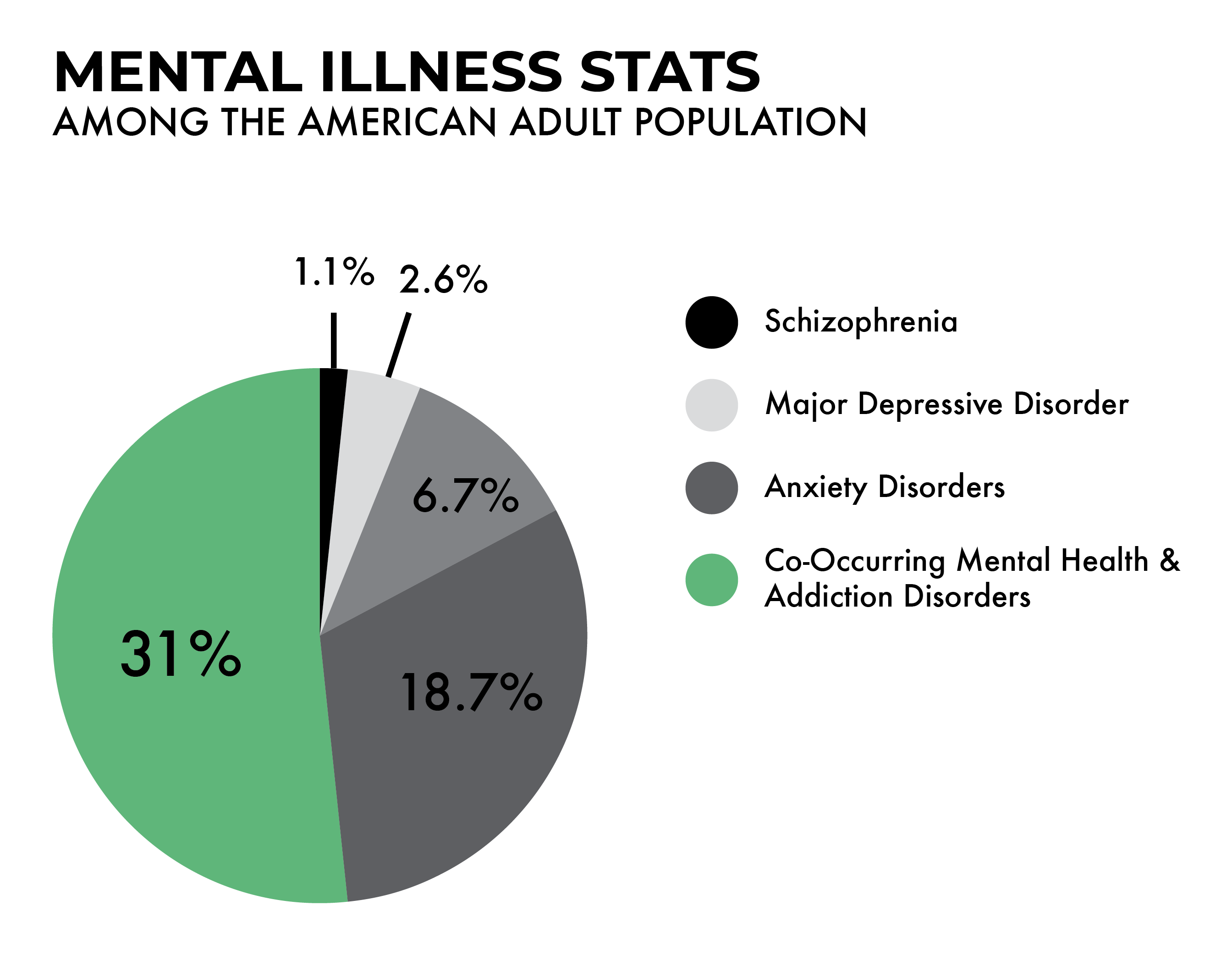
- About 2.4 million Americans, or 1.1 percent of the adult population, live with schizophrenia.
- Bipolar disorder affects 5.7 million American adults, approximately 2.6 percent of the adult population per year.
- Major depressive disorder affects 6.7 percent of adults or about 14.8 million American adults.1 According to the 2004 World Health Report, this is the leading cause of disability in the United States and Canada in ages between 15-44.
- Anxiety disorders, including panic disorder, obsessive-compulsive disorder (OCD), posttraumatic stress disorder (PTSD), generalized anxiety disorder and phobias, affect about 18.7 percent of adults, an estimated 40 million individuals. Anxiety disorders frequently co-occur with depression or addiction disorders.
- An estimated 5.2 million adults have co-occurring mental health and addiction disorders. Of adults using homeless services, 31 percent reported having a combination of these conditions.
- One-half of all lifetime cases of mental illness begin by age 14, three-quarters by age 24.6
- Fewer than one-third of adults and one-half of children with a diagnosable mental disorder receive mental health services in a given year.
- In the United States, the annual economic, indirect cost of mental illness is estimated to be $79 billion. Most of that amount— approximately $63 billion—reflects the loss of productivity as a result of illnesses.
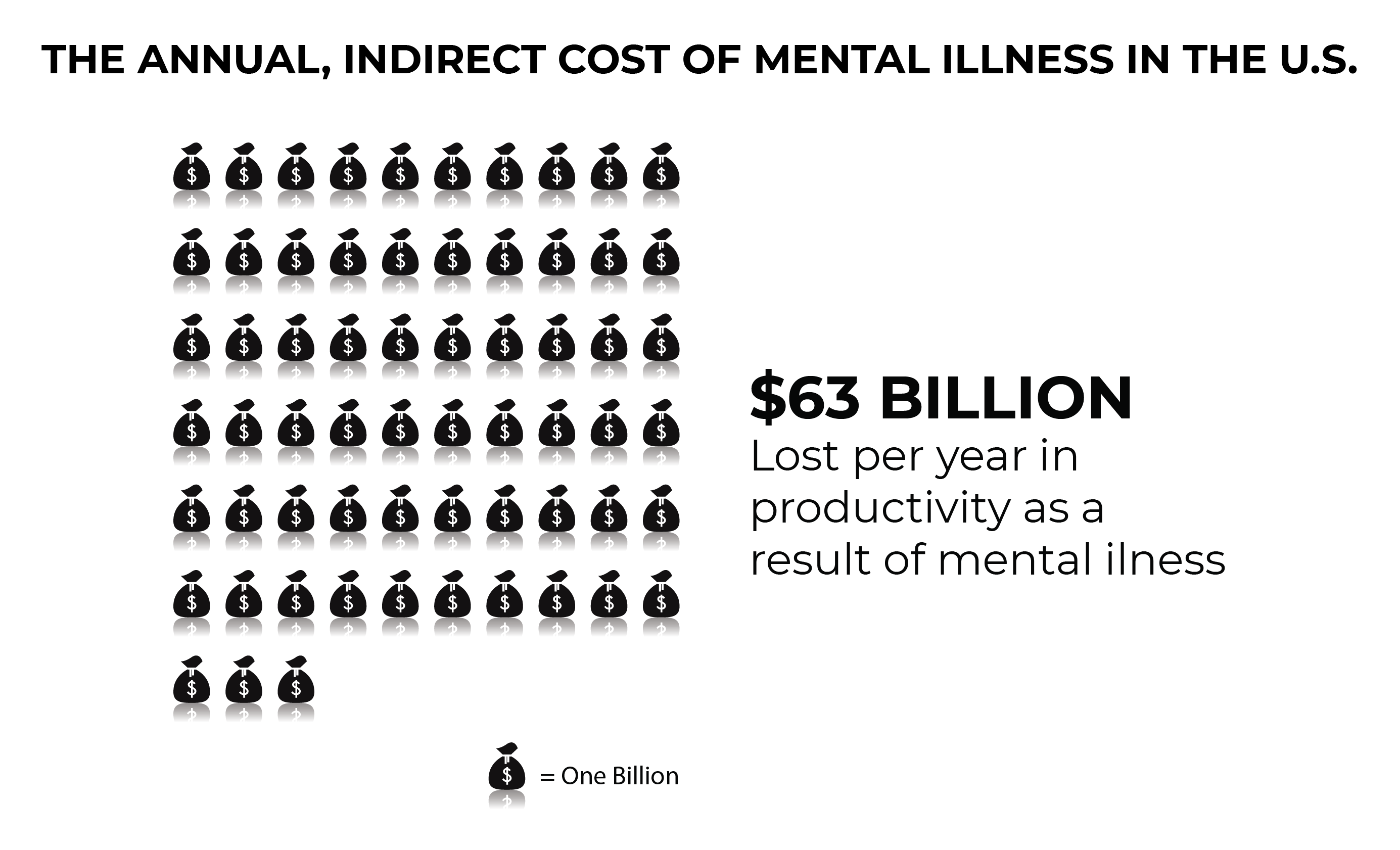
- Individuals living with serious mental illness face an increased risk of having chronic medical conditions. Adults living with a serious mental illness die 25 years earlier than other Americans, largely due to treatable medical conditions.
Suicide
- Suicide is the eleventh leading cause of death in the United States and the third-leading cause of death for people ages 10-24 years.
- More than 90 percent of those who die by suicide have a diagnosable mental disorder.
- In July 2007, a nationwide report indicated that male veterans are twice as likely to die by suicide as compared with their civilian peers in the general United States population.
- Twenty-four percent of state prisoners and 21 percent of local jail prisoners have a recent history of a mental health disorder.
- Seventy percent of youth in juvenile justice systems have at least one mental disorder with at least 20 percent experiencing significant functional impairment from a serious mental illness.
- Over 50 percent of students with a mental disorder age 14 and older drop out of high school—the highest dropout rate of any disability group.
According to an extensive report from the California Mental Health Program, the numbers of teenagers/youth with mental health breaks down thusly:
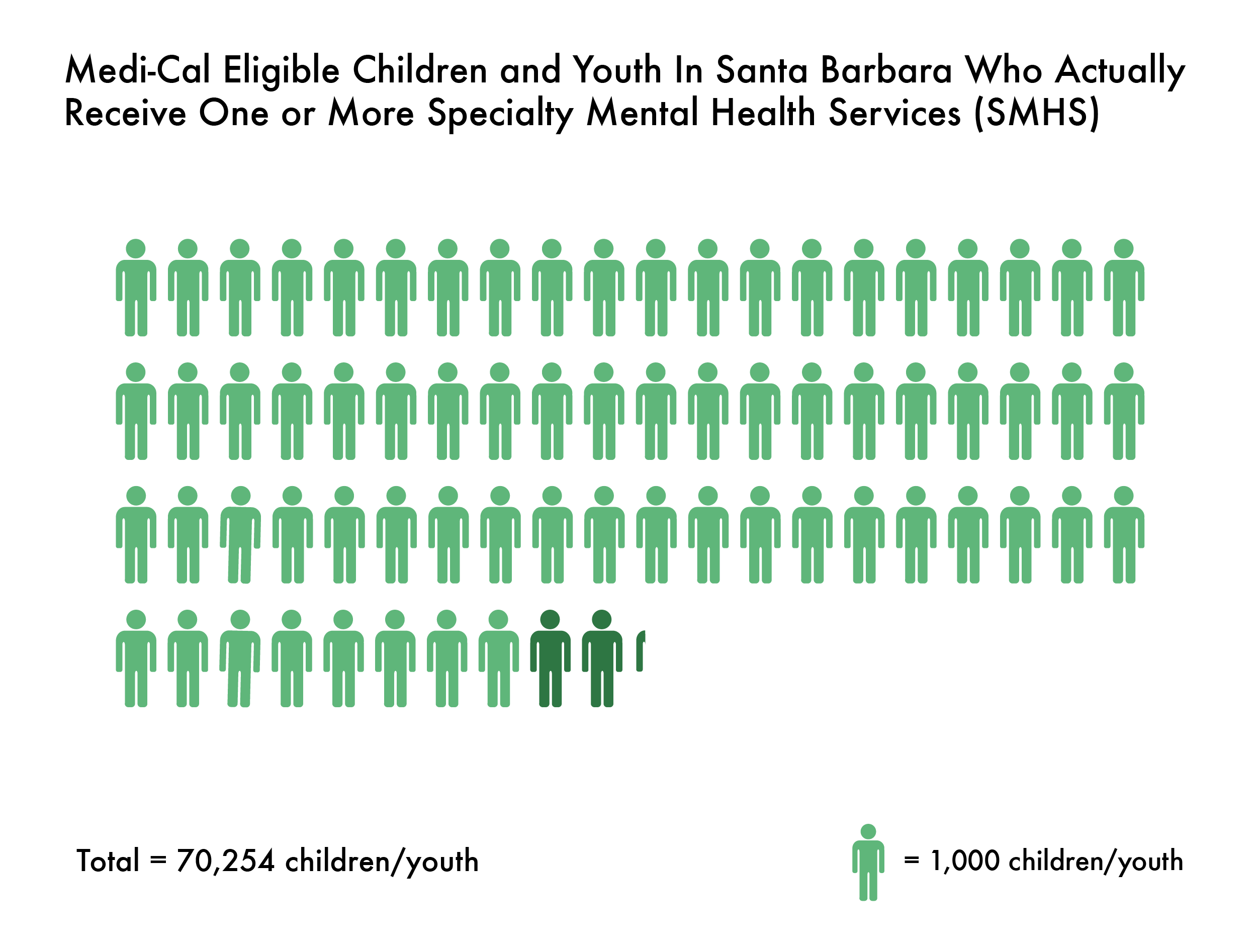
The unique numbers of children and youth who were Medi-Cal eligible in Santa Barbara: 70,254
Of those, the number of children and youth who received one or more Specialty Mental Health Services (SMHS): 2,342.
Major race/ethnicity groupings of children and youth who received one or more specialty mental health services during the fiscal year 2013-2014:
Asian/Pacific Islander 2%
Black 3%
Hispanic 21%
White 68%
Unknown 5%
Age groups of children and youth who received one or more specialty mental health services:
Children 0-5 21%
Children 6-11 31%
Children 12-17 37%
Youth 18-20 11%
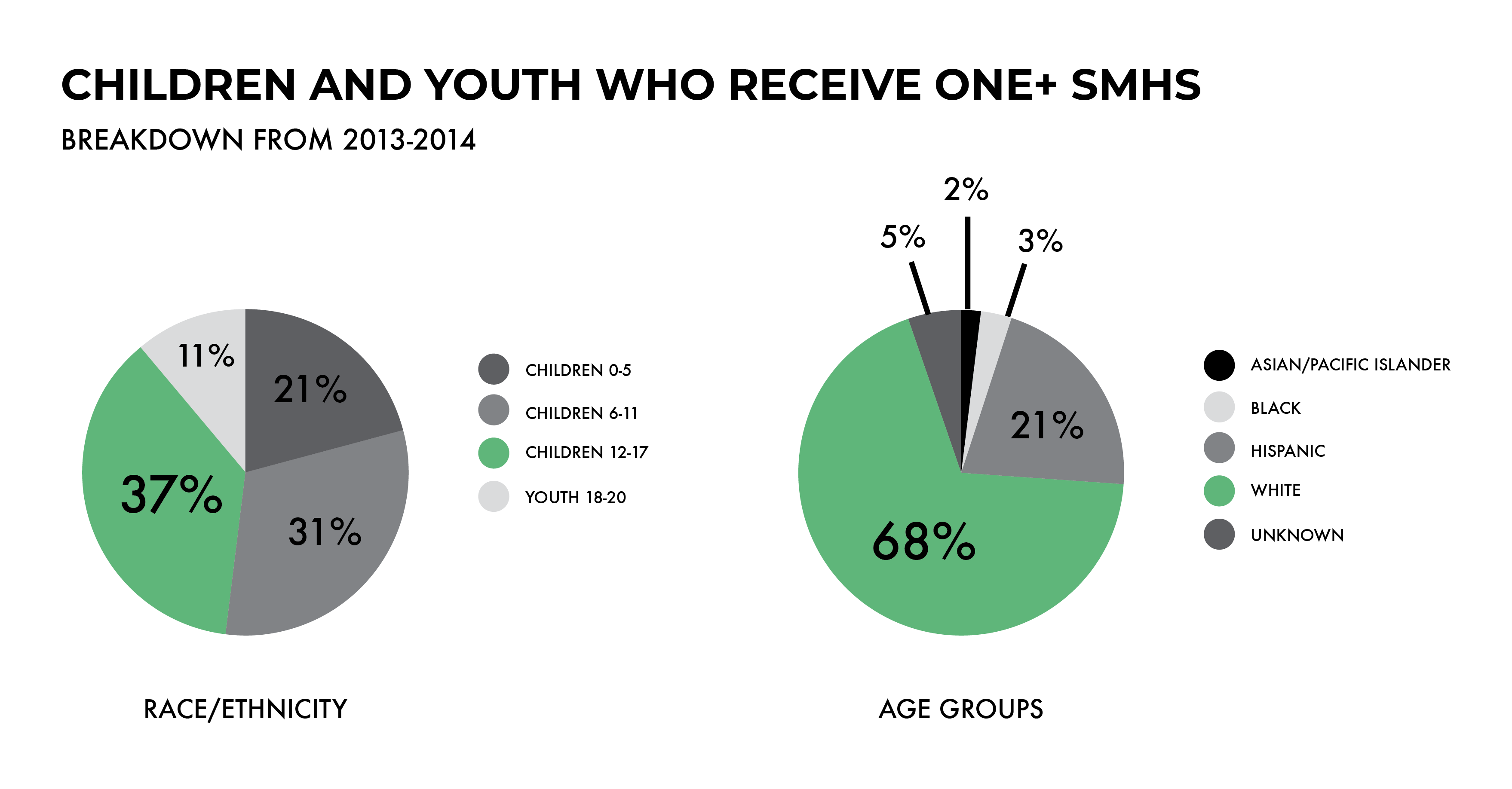
Santa Barbara County provides outreach as well as education related to First Episode Psychosis (FEP) in high schools and has also contracted with local colleges to include peer health educators on campuses. In addition, there is coordination with Social services, probation, the Department of Rehabilitation, as well as the public Health Department all to provide education about services offered to transition-aged youth.
Santa Barbara has promised to continue outreach efforts to marginalized populations. Specifically, the County will continue to work with community stakeholders in the efforts to outreach to populations including Latino indigenous, LGBTQ, and African American populations.
In the County’s Transitional Age Youth program, the Transition to Independence Program (TIP) model is used to provide parent education. Additionally, through the FEP program, the County has developed parent literature and outreach materials. The TIP model encourages active engagement between treatment teams and family members due to the impact of the first diagnosis of Psychosis.
The County contracts with Casa Pacifica to operate the SAFTY program, which provides crisis intervention services, short-term treatment and linkage to longer-term services, and post-hospital discharge aftercare. Transition-Age Youth (TAY) discharged from hospitals are connected to the TAY programs in the county ’s outpatient clinics.
Foster children/youth make up a vulnerable group that faces a considerable threat to mental illness. Mental health consequences may result from the traumatic experiences which led to their placement in foster care. Foster children and youth are just 1.3% of all Medi-Cal eligible children and youth (ages 0-20). However, they represent 13% of the total children and youth who received Specialty Mental Health Services (SMHS) in one year (FY 2013 – 2014). SMHS are services provided to children and youth with serious emotional disorders (SED) or to adults with serious mental illness (SMI).
For 2012-2014, the breakdown of foster kids in Santa Barbara who were receiving help for mental health issues are:
2012 – 59%
2013 – 59%
2014 – 52%
That compares to the national averages for the same three years thusly:
2012 – 52%
2013 – 51%
2014 – 49%
The amount of students who have reported suicidal thoughts in Santa Barbara from 2011-2013 breaks down like this:
9th Grade: 17.8%
11th Grade: 16.4%
Non-Traditional: 20.8%
All 17.7%
There are a number of programs and services in Santa Barbara that are listed by the Mental Health Services Oversight and Accountability Commission. They include:
CARES Mobile Crisis Team
A mobile crisis team available 24/7 was added to the ADMHS CARES (Crisis and Recovery Emergency Services) program to provide clients in crisis appropriate alternatives to hospitalization. Mobile crisis response teams collaborate with law enforcement crisis.
Crisis Intervention Training (CIT)
Intended for law enforcement officers who are often the first point of contact for people in crisis and psychiatric emergency.
CARES (Crisis and Recovery Emergency Services)
Consolidates crisis stabilization, intake, mobile crisis response and access to service for mental health and alcohol and drug emergencies. Staffed by mental health professionals, CARES provides crisis support on a 24/7 basis, serves children and adults.
Assertive Community Treatment (ACT)
Evidence-based approach helps people with severe mental illness who have co-occurring life issues, including alcohol and drug use. Deploys multidisciplinary teams responsible for providing services, including housing assistance and supported employment.
County ACCESS 24-Hour crisis line:
1-888-868-1649 – Provides inpatient, outpatient and crisis basis services for individuals with moderate-to-severe mental health and/or alcohol and substance-use conditions throughout Santa Barbara County. Services are available in Spanish and additional languages.
24-Hour Mental Health Referral Hotline:
211 – the Toll-free line that provides mental health and substance-use information, referrals, and crisis response. Clinicians are available 24/7, weekends and holidays for all of Santa Barbara County. Services are available in Spanish and additional languages. If an individual is experiencing a mental health crisis that places anyone in immediate danger, call 911.
National Suicide Prevention Lifeline:
800-273-8255
Alcohol Hotline Support & Information:
800-331-2900
Grief Recovery Helpline:
800-445-4808
National Youth Crisis Hotline:
800-448-4663
Other Santa Barbara organizations that offer aid and assistance include:
Child Abuse Listening and Meditation (CALM)
Provides counseling for individuals and families, as well as treatment for trauma survivors and offenders. Located at: 1236 Chapala Street, 93101. (805) 965-2376
Council on Alcoholism and Drug Abuse (CADA)
Provides a variety of counseling services and treatment for substance abuse and addiction; services available for all ages. Located at: 232 East Canon Perdido, 93101. (805) 963-1433
24-Hour Crisis Line: 805-964-5245
Family Service Agency (FSA)
Provides counseling services for individuals, couples, and families of all ages, as well as a free caregiver support group. Located at: 123 West Gutierrez Street, 93101. (805) 965-1001
SB County Department of Behavioral Wellness (Be Well)
Provides assessments; mental health services for children with serious emotional disturbance, adults with serious mental illness, and all Medi-Cal beneficiaries with specialty mental health needs; crisis interventional and substance abuse prevention, interventions, and treatment.
According to the Santa Maria Sun, in December 2016, 174 inmates at the Santa Barbara County Jail were taking psychotropic mental health medication. This accounted for 17 percent of the jail’s total population. In the same year, sheriff’s deputies responded to an average of 29 mental health-related calls each week. State statistics say more than 5 percent of the population requires mental health services.
The National Institute of Mental Health’s stats on major depression related to medical illnesses breaks down thusly:

25% of cancer patients
33% of heart attack survivors
27% of substance abusers (alcohol and other drugs)
10-27% of stroke victims
33% of HIV survivors
50% of Parkinson disease patients
8-27% of diabetic patients
50-75% of eating disorder patients.
People suffering from depression are at four times the risk for a heart attack than those without it. After a heart attack, untreated depression may increase the risk of death or cause a second heart attack. According to the Wall Street Journal, depression costs American businesses $70 billion in medical expenses, lost productivity, and other workplace costs annually. Fortunately, the National Institute of Mental Health estimates that 80% of people who get treatment receive partial relief in four-six weeks.
Rates of Treatment-Seeking for Mental Health
Mental health conditions like depression are relatively prevalent, meaning that a significant number of people will require treatment for these conditions. According to data from the CDC, 19.2% of American adults receive mental health treatment in a given year; 15.8% take medication to treat a mental health condition, and 9.5% receive therapy or counseling for mental health.
When compared to men, women are more likely to seek treatment, including counseling and medication. Non-Hispanic Whites are also more likely to seek mental health services when compared to those who are Black or Hispanic. Furthermore, younger adults are more likely to seek mental health counseling when compared to middle-aged and older adults. On the other hand, middle-aged and older adults are more likely than younger adults are to take medication to treat a mental health condition.
The state of California also collects data on the usage of mental health services. According to a recent report, for every 1,000 people in California’s population, 17.48 received mental health care in 2018, compared to 23.69 per 1,000 people in the United States as a whole. The use of mental health services in California may be slightly lower than the general rate across the country.
According to research, common barriers to seeking mental health care include the belief that treatment is unnecessary, and some have a desire to handle the problem without help. Other barriers to getting treatment for a mental health condition include:

If you are struggling with a mental health condition, know that you are not alone and help is available. For those in the Santa Barbara area, Mission Harbor Behavioral Health offers mental health treatment for adolescents and adults. We provide several levels of care for adults, including intensive outpatient programming with a flexible schedule to meet the needs of those working, caring for families, and balancing other responsibilities. Call us today to determine the treatment option that is best for you. If you are concerned about cost, we are in-network with many major health insurance providers, including Anthem Blue Cross, United Healthcare, Cigna, and Optum.
Updated content on 4/23/2021
This guide is intended to be informational. If you are considering help for you or your loved one and would like more information, please consult a medical professional or licensed treatment facility.

